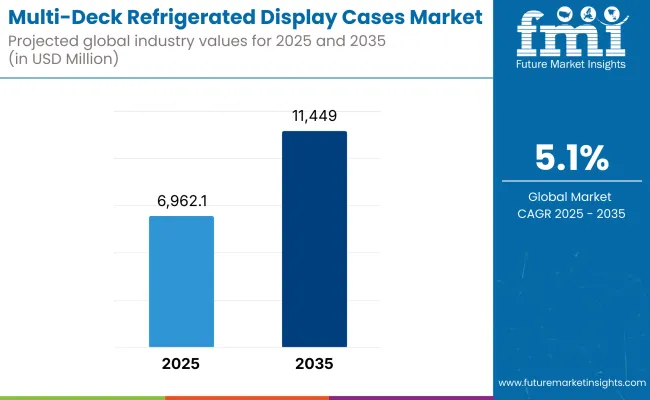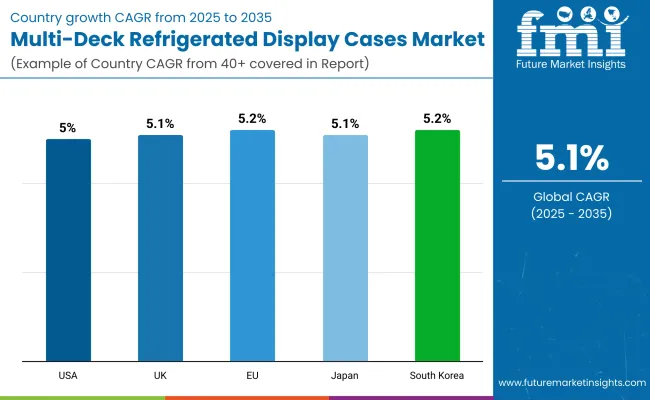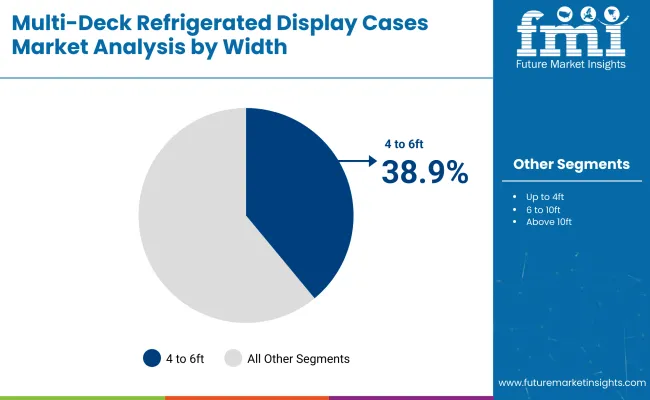The multi-deck refrigerated display cases market is projected to grow significantly from 2025 to 2035, thanks to the expanding retail sector, increased demand for energy-efficient refrigeration solutions, and the growing adoption of smart cooling technologies.
Supermarkets, hypermarkets, and convenience stores are updating their refrigeration to meet stricter energy regulations and sustainability objectives. Furthermore, the industry is being redefined as a result of advancements in smart sensors, IoT-enabled temperature monitoring, and ecologically friendly refrigerants.
The global value-aligned wallet as a service is expected to grow from USD 6,962.1 Million in 2025 to USD 11,449.0 Million by 2035, at a CAGR of 5.1 % during the forecast period. Growing demand for fresh and perishable food products coupled with strong demand for grab-and-go retail formats will continue to propel demand for multi-deck refrigerated display cases.

The North America region is one of the most important markets in terms of multi deck refrigerated display cases due to stringent regulations regarding food safety, increasing need for energy efficient refrigeration systems, and expanding supermarket chains in this region. The USA and Canada will soon adopt low-carbon refrigeration technologies such as hydrocarbon-based refrigerants and on-board smart cooling solutions by retailers in line with EPA and DOE energy efficiency regulations.
Europe is a key player in the market due to stringent EU regulations regarding refrigerants, an increase in the adoption of low-GWP (Global Warming Potential) cooling technologies, and initiatives geared at sustainable retail infrastructure.
Other countries, such as Germany, the UK, and France are also investing in AI-controlled temperature smart refrigeration system which not only helps preserve food but also reduces energy consumption by preventing food from going bad. Supermarket chains throughout the region are converting to CO₂-based refrigeration systems to comply with the EU’s F-Gas Regulation.
Asia-Pacific will register the highest growth, driven by urbanization, rapid expansion of supermarkets and convenience stores, and increase in disposable income. Zero-energy refrigerators are popular in China, India, Japan and South Korea thanks to government incentives for energy-efficient appliances and rising food retail investments. Growing popularity of quick-service restaurants (QSRs) and e-commerce grocery stores also supported easy accessibility and demand for advance refrigerated display cases.
Challenge:
High Initial Investment and Maintenance Costs
A high upfront investment in energy-efficient multi-deck refrigerated display cases makes it difficult for small retailers and operators of convenience stores to modernize their refrigeration systems. Advanced cooling technologies, digital temperature monitoring, and refrigerant compliance contribute to maintenance costs that drive operational expenses. To address this, manufacturers are pivoting towards modular and cost-effective refrigeration solutions for affordability.
Opportunity:
Growing Demand for Smart and Eco-Friendly Refrigeration Systems
The transition toward smart refrigeration types creates a great growth opportunity. With the aim of improving efficiency, more and more retailers are harnessing the power of IoT for temperature monitoring, predictive maintenance solutions, and AI-based cooling systems that can support operational cost reductions.
Strict environmental regulations, environmental goals, and new guidelines have also been in favour of natural refrigerants such as CO₂, ammonia, and propane. The evolving market will favour smart, sustainable and connected refrigeration solutions, companies investing in such solutions can maintain a competitive edge.
The growth for multi-deck refrigerated display cases from 2020 to 2024 is primarily attributed to expanding retail sector, increasing demand of fresh food from consumers, energy efficiency regulations. A rise in open-front and glass-door refrigerated display cases in supermarkets, convenience stores, and hypermarkets also resulted in improved product visibility as well as energy savings.
The second one was governments all over the world introducing very stringent energy efficiency standards and low-GWP (Global Warming Potential) refrigerant regulations that accelerated the adoption of natural refrigerants like CO2 and hydrocarbons. Retailers sought smart refrigeration systems that paired with LED lighting, automated defrosting, and real-time temperature monitoring to maximize efficiency and lower operating costs.
However, high initial investment costs, space limitations, and variable prices of raw materials affected the market growth. But technological advances with modular and plug-in refrigerated cases have helped alleviate those concerns, making the equipment more palatable for small and mid-tier retailers.
From 2025 to 2035, the market for multi-deck refrigerated display cases will witness noteworthy changes due to AI-integrated automation, IoT-enabled connectivity, and sustainability-centric refrigeration systems.By integrating AI into energy optimization solutions, retailers will be able to monitor temperature, product stocking levels, customer interactions in real time, thereby helping them to improve the preservation of food products as well as save energy. Predictive maintenance algorithms will be employed to increase equipment lifespan and decrease downtime.
It will be driven by sustainability with completely recyclable display cases and solar-powered refrigeration as well as an ultra-low GWP refrigerants. The rising regulatory restrictions will see conventional refrigeration systems based on HFC models replaced by hydrocarbon and CO2-based systems.
Modular, self-contained refrigeration units with smart connectivity will be more widely adopted by retailers, allowing them to easily customize their store layouts and providing greater operational flexibility. The growth of e-commerce driven grocery formats will drive demand for automated, temperature-controlled fulfilment centres that interface with modern refrigerated display cases.
Market Shifts: A Comparative Analysis 2020 to 2024 vs. 2025 to 2035
| Market Shift | 2020 to 2024 |
|---|---|
| Energy Efficiency | Adoption of LED lighting, automated defrosting. |
| Refrigerant Transition | Shift to natural refrigerants (CO2, hydrocarbons). |
| Retail Store Adaptation | Increased use in supermarkets, hypermarkets, and small retailers. |
| Smart & Connected Systems | Basic digital temperature monitoring. |
| Customization & Modularity | Traditional fixed-installation units. |
| Market Growth Drivers | Regulatory mandates, demand for fresh food. |
| Market Shift | 2025 to 2035 |
|---|---|
| Energy Efficiency | AI-driven energy optimization, smart temperature controls. |
| Refrigerant Transition | Full-scale adoption of ultra-low GWP and solar-powered refrigeration. |
| Retail Store Adaptation | Expansion into automated grocery fulfillment centers and e-commerce-driven stores. |
| Smart & Connected Systems | IoT-enabled predictive maintenance and remote-controlled cooling systems. |
| Customization & Modularity | Modular, plug-in refrigerated display cases for flexible store layouts. |
| Market Growth Drivers | AI-powered refrigeration, e-commerce grocery expansion, and sustainability initiatives. |

The expanding grocery store chains, convenience stores and hyper-market are some factors accountable for the growth of USA multi-deck refrigerated display cases market. Market dynamics are influenced by the rising consumption of both fresh and frozen food items, as well as the growing emphasis on energy-efficient refrigeration systems.
Regulatory policies supporting eco-friendly refrigerants and high-performance cooling technologies also stimulate product adoption. To provide the utmost food safety to consumers and reduce energy consumption, retailers are replacing their traditional multi-deck units with advanced models that feature smart temperature control and IoT-based monitoring.
| Country | CAGR (2025 to 2035) |
|---|---|
| United States | 5.0% |
The UK market can still be considered as steadily growing due to supportive factors such as increasing demand for grab-and-go food products as well as growing number of small-format grocery stores. Tight regulations on carbon emissions and the ban of hydrofluorocarbon (HFC) refrigerants are the key factors driving sustainable multi-deck refrigeration systems.
The adoption of energy-efficient and low-maintenance display cases are some of the key trends supporting retailers and food service providers to manage operational costs. Technological advancements like LED lighting, smart defrost systems, and digital displays are making these appliances more functional and appealing.
| Country | CAGR (2025 to 2035) |
|---|---|
| United Kingdom | 5.1% |
The stringent regulations for energy conservation and sustainability make Europe one of the major markets for multi-deck refrigerated display cases. Germany, France, and Italy are implementing strict energy policy, while they promote the use of display cases that improve insulation and customers use advanced cooling technology.
Consumer demand for organic and fresh produce are also driving retailers to newer high-visibility, open-front, and glass-door refrigerated display cases. The growth of discount supermarkets and hypermarkets in Eastern Europe is also driving market growth.
| Country | CAGR (2025 to 2035) |
|---|---|
| European Union (EU) | 5.2% |
Rising convenience store product, packaged meal, and frozen food sales are fuelling growth of multi-deck refrigerated display case market in Japan. A national priority on small footprint, high-efficiency, environment-friendly refrigeration systems is spurring display case innovation.
Therefore, Japanese retailers implement AI-based cooling solutions, automated maintenance alerts and remote energy monitoring to optimize refrigeration performance. This supports the Japanese desire to reduce emissions of greenhouse gases into the atmosphere, with the increasing usage of CO2-based and hydrocarbon refrigerants in commercial refrigeration.
| Country | CAGR (2025 to 2035) |
|---|---|
| Japan | 5.1% |
In South Korea, there is a growing demand for multi-deck refrigerated display cases due to increasing penetration of modern retail formats including hypermarkets and specialty grocery stores. Government policies that encourage energy-efficient appliances and eliminate ozone-depleting substances are accelerating the transition for retailers.
This growth in demand for online grocery shopping also forces the demand for the cold chain logistics and refrigerated display units in the urbanized distribution centre. Increasing share of smart refrigeration solutions with IoT, AI, and real-time temperature monitoring
| Country | CAGR (2025 to 2035) |
|---|---|
| South Korea | 5.2% |

| By Type | Market Share (2025) |
|---|---|
| Plug-In Multi-Deck Refrigerated Display Case | 47.3% |
Based on type, the plug-in multi-deck refrigerated display case is projected to capture the largest market share segment through 2031 due to ease of installation, and flexibility & cost-effectiveness. Plug-in units are preferred by business types like supermarkets, convenience stores and specialty food outlets, as they do not require external refrigeration systems. These units are equipped with self-contained compressors, which means retailers can put these anywhere without any additional piping or altering of refrigeration infrastructure.
Retailers value the true plug and play nature of these refrigerated display cases providing increased layout flexibility to take advantage of customer traffic flow and seasonal merchandising needs. The portability of plug-in units also makes them ideal for small- and medium-sized enterprises (SMEs) that denounce installation. With advanced cooling technology to support reduced operating costs while enabling freshness, the newest energy-efficient models help retailers find a balance when it comes to reducing their overall operating costs.
Incorporating advanced features such as LED lighting, digital temperature controls, and energy-efficient compressors to enhance product visibility and reduce energy consumption. As international regulations to lower greenhouse gas emissions intensify, increasing the focus on sustainability to adopt green refrigerants in plug-in display cases. Plug-in multi-deck refrigerated display case market trends include the rising utilization of urban retail spaces and convenience shopping trends that help broaden the market scope.

| By Width | Market Share (2025) |
|---|---|
| 4 to 6ft Multi-Deck Refrigerated Display Case | 38.9% |
4 to 6ft multi deck refrigerated display case segment is likely to be preferred by retailers for the capacity that it provides while being close to space efficient. With sufficient shelving to showcase perishable products, such as dairy items, produce, drinks, and prepared foods, these models also have a small footprint that can fit in many retail settings.
These display cases are used by supermarkets, grocery stores, food service locations to showcase products in an attractive design to maximize impulse purchases. With its tiered shelving design, the display promotes best-in-class product visibility and accessibility while providing retailers with the opportunity to maximize space with a limited footprint. Adjustable shelving options allow retailers to modify the display setup, intending to adapt to various product sizes and packaging formats.
Energy-efficient refrigerators in this segment employ advanced insulation techniques, high-efficiency cooling mechanisms, and motion-sensing LED lights to significantly curb energy use. Smart temperature monitoring and remote control features get added to the operational effects in conjunction with refilling quantity in enhancement, where it ensures constant refrigeration and minimizes maintenance expenses.
4 to 6ft refrigerated display cases are popular for retailers as they can fit or adapt into any basic store layouts and product categories. The segment of multi-deck refrigerated display cases is driven by the growing demand for fresh and chilled food products and the expanding landscape of retail formats that focus on convenience.
The Multi-Deck Refrigerated Display Cases Market is being propelled by growing demand for energy-efficient refrigeration solutions, supermarket and convenience store expansions, and technological advancements in cooling systems. To comply, companies prioritize product efficiency, sustainability and design innovations. Leading firms invest in next-generation refrigeration systems that enhance temperature control, energy efficiency, and supermarket display aesthetics.
Market Share Analysis by Company
| Company Name | Estimated Market Share (%) |
|---|---|
| Blue Star Limited | 18-22% |
| Carrier Corporation | 14-18% |
| Frigoglass SAIC | 12-16% |
| Epta S.p.a. Refrigeration | 10-14% |
| Other Companies (combined) | 30-40% |
| Company Name | Key Offerings/Activities |
|---|---|
| Blue Star Limited | In 2024, introduced high-efficiency multi-deck refrigerated display cases with enhanced energy-saving features. |
| Carrier Corporation | In 2025, expanded its portfolio with advanced smart refrigeration systems for retail chains. |
| Frigoglass SAIC | In 2024, launched eco-friendly display cases with optimized cooling performance. |
| Epta S.p.a. Refrigeration | In 2025, developed innovative modular refrigerated display solutions to maximize store space utilization. |
Key Company Insights
Blue Star Limited (18-22%)
Blue Star leads the market by offering energy-efficient multi-deck refrigerated display cases tailored for modern retail environments.
Carrier Corporation (14-18%)
Carrier focuses on smart refrigeration systems, integrating IoT and AI-based temperature control for optimized energy consumption.
Frigoglass SAIC (12-16%)
Frigoglass emphasizes sustainability, designing eco-friendly display cases that improve cooling efficiency and reduce environmental impact.
Epta S.p.a. Refrigeration (10-14%)
Epta develops modular refrigeration solutions, allowing retailers to customize their display configurations for improved space utilization.
Other Key Players (30-40% Combined)
Several refrigeration technology companies contribute to market advancements, including:
The overall market size for the Multi-Deck Refrigerated Display Cases Market was USD 6,962.1 Million in 2025.
The Multi-Deck Refrigerated Display Cases Market is expected to reach USD 11,449.0 Million in 2035.
The demand is driven by increasing retail expansion, rising demand for fresh and frozen food products, growing adoption of energy-efficient refrigeration solutions, and stringent food safety regulations requiring advanced storage solutions in supermarkets and convenience stores.
The top 5 countries driving market growth are the USA, UK, Europe, Japan and South Korea.
The Plug-In Multi-Deck Refrigerated Display Case segment is expected to command a significant share over the assessment period.






Full Research Suite comprises of:
Market outlook & trends analysis
Interviews & case studies
Strategic recommendations
Vendor profiles & capabilities analysis
5-year forecasts
8 regions and 60+ country-level data splits
Market segment data splits
12 months of continuous data updates
DELIVERED AS:
PDF EXCEL ONLINE
Refrigerated Trailer Market Size and Share Forecast Outlook 2025 to 2035
Refrigerated Transport Market Size and Share Forecast Outlook 2025 to 2035
Refrigerated / Frozen Dough Products Market Size and Share Forecast Outlook 2025 to 2035
Refrigerated Ice Cream Merchandise Market Size and Share Forecast Outlook 2025 to 2035
Refrigerated Vending Machine Market Size and Share Forecast Outlook 2025 to 2035
Analysis and Growth Projections for Refrigerated and Frozen Soup Market
Refrigerated Snacks Market Trends - Healthy & Fresh Innovations 2025 to 2035
Refrigerated Vans Market Growth - Trends & Forecast 2025 to 2035
Refrigerated Display Case Market Size and Share Forecast Outlook 2025 to 2035
Slipcases Market Size and Share Forecast Outlook 2025 to 2035
Mobile cases and covers market Size, Share & Forecast 2025 to 2035
Bakery Cases Market Analysis – Trends, Growth & Forecast 2025 to 2035
Pillow Cases Market Analysis - Growth & Demand Forecast 2025 to 2035
Rugged Cases Market Insights – Trends & Forecast 2024-2034
Plastic Cases Market Size and Share Forecast Outlook 2025 to 2035
Utility Cases Market Insights - Growth & Demand 2025 to 2035
Transport Cases & Boxes Market Size and Share Forecast Outlook 2025 to 2035
Equipment cases market Size and Share Forecast Outlook 2025 to 2035
Market Share Distribution Among Transport Cases & Boxes Providers
Waterproof Cases Market

Thank you!
You will receive an email from our Business Development Manager. Please be sure to check your SPAM/JUNK folder too.
Chat With
MaRIA